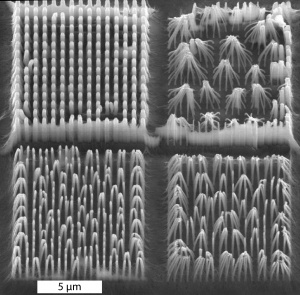Oct 18 2013
On Wednesday, Oct. 23, the University of Pennsylvania’s Nano/Bio Interface Center will host its annual NanoDay@Penn.
 "Nanowire Compliance," by Kate Murphy
"Nanowire Compliance," by Kate Murphy
This public education and outreach event will feature a series of talks, demonstrations and exhibits dealing with nanotechnology, a rapidly expanding scientific discipline that involves the manipulation of matter on the atomic and molecular scale.
Enabling the creation of new materials as well as new techniques for shaping them, nanotechnology research branches into alternative energy, computer hardware and a host of medical applications, including new drug delivery particles. As nanotechnology deals on length scales compatible with the most basic biological mechanisms, such as cellular receptors and even individual strands of DNA, researchers affiliated with the NBIC have a particular interest in combining these naturally occurring structures with artificial ones, like carbon nanotubes and graphene. Such hybrids could be used as sensitive chemical detectors or diagnostic devices.
With so much promise in the field, NanoDay aims to generate interest in the subject with the public and encourage budding young scientists to consider it in their career paths. To that end, the schedule of events includes tours of the new Krishna P. Singh Center for Nanotechnology for local high school students and a science fair for their nanotechnology themed projects.
For the general public, a slate of exhibits, live demonstrations and videos will run from 10 a.m. to 2 p.m. in Towne Hall.
NanoDay will culminate with an award ceremony for outstanding graduate student research and a keynote address given by a luminary in the field. This year’s keynote speaker and recipient of the Nano/Bio Interface Center’s Research Excellence Award is Joseph Lyding of the University of Illinois. Lyding's fundamental, atomic-scale experiments on how electrical current can remove atoms from a surface led to a technique known as "deuterium processing," which can lead to a 10-fold increase in the lifetime of microchips.
This year’s Graduate Student Research Award will be given to Jaehong Park, who, prior to graduating in May, was a doctoral candidate in the Department of Chemistry in Penn’s School of Arts and Sciences.
“One of the most compelling directions in nanotechnology research is new methods of energy production, and especially solar energy,” said A.T. Charlie Johnson, professor of physics in the School of Arts and Sciences and director of the NBIC. “Jaehong’s experiments in how to control light absorption by carbon nanotubes give us new insight into how that energy can better be siphoned out for other uses and bring us a step closer to the use of nanotubes in solar energy applications.”
The NBIC also calls on students to submit images produced in the course of research for awards in three categories: scientific, artistic and animation.
Kate Murphy, a doctoral candidate in Penn’s School of Engineering and Applied Science’s Department of Materials Science and Engineering, is this year's winner in the scientific category. Her image, "Nanowire Compliance," shows how normally stiff and brittle silicon wires become highly flexible when their diameter is reduced to the nanoscale.
Lisa Chen, also a doctoral candidate in materials science and engineering, is this year's winner in the artistic category, for "BMG Flower." Her image shows how new materials known as "metallic glasses" can be impressed with nanoscale features without breaking or failing and, in this case, forming structures that look like the pistil of a flower.
Andrew Voyiadjis, a postdoctoral fellow in the Department of Neurosurgery at Penn’s Perelman School of Medicine, is this year's winner for the animation category. His "Axonal Injury in the Brain following a Head Impact" shows the dynamics of neurons’ microtubules following a brain injury.
“I'm always impressed by how students are able to combine scientific research with graphic arts,” Johnson said. “Electron microscopy and computer simulation are two methods for understanding nanoscale systems, and they often lead to beautiful images that both provide scientific insight and inspire our imaginations.”
The award ceremony will be held at 4 p.m. in the Singh Center’s Glandt Forum.